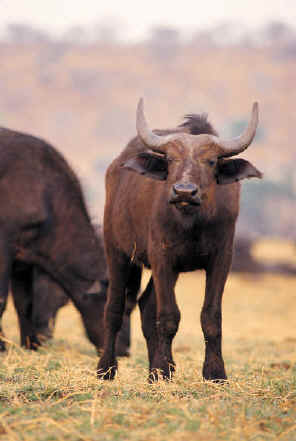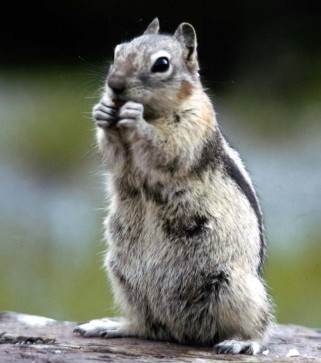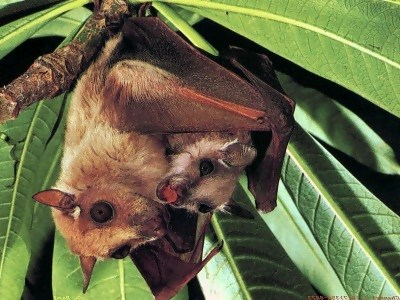
Mammals are vertebrates (backboned animals) that feed their young on
mother's milk. There are approximately 4,260 species of mammals.
| When you think of an animal it is likely to be a mammal.
People are mammals. Cats and dogs are mammals. So are such farm animals as cattle, goats, hogs, and horses. Mammals also include such fascinating animals as
porcupines, gorillas, giraffes, rhinoceroses and kangaroos.
Mammals are found to exist all over the world in all different climates. Mammals such as chimpanzees and elephants dwell in tropical regions. Arctic foxes, polar bears and many other mammals make their home near the North Pole. Camels and coyotes live in deserts. Some mammals even live in the sea such as dolphins, seals and whales. One group of mammals, the bats, can fly.
|
 |
Characteristics of a Mammal
These characteristics are common to all mammals:
| Mammals nurse their babies. They feed them on the mother's milk. Mammals have to eat a lot of food to maintain their high body temperature. | |
| Most mammals give their young more protection and training than do other animals. | |
| Only mammals have hair. All mammals have hair at some time in their life, though in certain whales it is present only before birth. | |
| Mammals are warm-blooded. Their body temperature remains about the same all the time, even though the temperature of their surroundings may change. Birds are also warm-blooded, but animal groups such as fish, birds, reptiles and amphibians are not. | |
| Mammals have a larger, more well-developed brain than do other animals. Some mammals, such as chimpanzees, dolphins, and especially human beings, are highly intelligent. | |
| Mammals are able to move around using limbs. |
![]()
| Humans are warm-blooded animals, so are all other mammals,
to a certain extent, and birds. However warm blood is not really the
question, many reptiles have blood far warmer than ours, but only on hot
days.
In fact, blood temperature is merely a reflection of body temperature. The important thing about mammals and birds is that they maintain a constant internal temperature. This is called being homeothermic and it involves not just generating your own heat when the surrounding temperature is low, but also finding ways to cool down when the ambient temperature is too high. |
 |
Reptiles and many other animals, particularly most insects live at the temperature of the world around them - cold when it is cold and hot when it is hot - this is called poikilothermy, or being poikilothermic. Endothermy means generating heat internally. All mammals are endothermic and most are homeothermic.
Mammals maintain their inner temperature by burning food (oxidation) through digestion and they stay cool by sweating, panting and changing postures and place in the world. Sweating and panting work by generating heat loss through evaporating water; changing posture allows mammals to control to some extent the heat absorbed from the world around them; while changing position simply means seeking shade or shelter when it is too hot.
 |
Being warm-blooded gives mammals a distinct advantage in
may habitats, allowing them to be active when reptiles are hardly able
to move. It also allows mammals to live in habitats where reptiles
cannot live at all, such as the arctic, mountain tops, etc. The reason
behind this is that muscle activity is basically dependent on chemical
reactions, as are all biological functions. Chemical reactions run
slowly when it is cold, but quickly when it is hot. This is because heat
is the same as energy. The more energy you have, the faster the chemical
reaction occurs. In the early mammals being endothermic probably allowed
them to be active at night when competing reptiles were forced to rest
or be sluggish.
|
Only mammals sweat, but not all mammals have the same number of sweat glands. For instance while primates have sweat glands all over their bodies, cats and dogs only have then in their feet and golden moles and whales don't have any.
![]()
Hair
 |
Skin and hair cover the body of mammals. Skin consists of an inner layer, the
dermis, and an outer layer, the epidermis. The dermis contains the arteries and veins that supply the skin with blood. The epidermis, which has no blood vessels, protects the dermis. It also produces special skin
structures such as hair, horns, claws, nails and hoofs. Many mammals have two coats of hair. The underhair consists of soft, fine hairs that provide a thick, warm coat. The outer guard hair consists of longer, slightly stiffened hairs that give shape to a mammal's coat and protect the underhair. |
Hair serves many purposes. The hair colour of many mammals blends with the animals' surroundings and so helps them hide from their enemies or prey.
There are basically four different types of body coverings that mammals posses.
|
Some mammals have specialized guard hairs, such as the quills on a porcupine or spiny anteater, that provide protection from enemies. But the main purpose of hair is to keep the animal warm. | |
|
Other mammals such as people, horses and gorillas, have hair. | |
|
Many mammals have thick fur such as grizzly bears, cats, dogs, lions and tigers. | |
|
Bristles are found on the backs of wild hogs and boars. |
Dolphins and whales, which lack body hair, have a thick layer of fat that provides warmth. Other mammals with little hair, such as elephants and rhinoceroses, live in warm climates.

![]()
Diet
 |
Mammals have to eat a lot to maintain their high body temperature. Diets vary from genus to genus. There are four basic types of mammalian diets.
|
![]()
Limbs and Movement
|
Mammals have different ways of moving around. Bat are able to fly through the use of wings. They are the only mammals that can actually fly. Flying lemurs, flying phalangers, and flying squirrels cannot actually fly. These mammals have a fold of skin between the forelimb and hindlimb on each side of the body. By stretching out these "wings," the animals can glide from tree to tree. Other mammals walk using legs such as cats, dogs, horses, apes and of course, people. Other mammals, particularly marine mammals, move through the use of flippers. These animals include sea otters, dolphins, seals, walruses and whales. Some mammals even have fins! The Fin whale is the second largest animal on earth and can reach a length of up to 27 metres. The whale has a dorsal fin on the rear half of its back.
|
 |